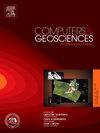Recognition of multiple geochemical anomalies by dual-branch convolutional neural network with adaptive feature fusion
IF 4.4
2区 地球科学
Q1 COMPUTER SCIENCE, INTERDISCIPLINARY APPLICATIONS
引用次数: 0
Abstract
Geochemical anomalies are critical indicators for mineral exploration and resource evaluation. However, due to the diversity and complexity of geological processes, identifying geochemical anomalies remains challenging. This study proposes a dual-branch convolutional neural network based on adaptive feature fusion (1-2D AFFCNN) to simultaneously extract the spectral compositional relationships and spatial structural features of geochemical elements. The model incorporates an Adaptive Feature Fusion Module (AFFM) to effectively integrate features from different branches, significantly improving predictive performance and robustness. Experimental results demonstrate that the 1-2D AFFCNN outperforms traditional single models in terms of accuracy (92.3 %), recall (92.0 %), and AUC value (0.98). The three-stage training strategy effectively mitigates the vanishing gradient problem, enhancing training efficiency and stability. In the application to the Changba ore-concentrated area in Gansu Province, the high-probability anomaly zones generated by the model are highly consistent with the spatial distribution of known lead-zinc deposits, and several high-potential mineralization areas were identified. This study not only provides a novel approach for the comprehensive analysis of multidimensional geochemical data but also opens new avenues for mineral resource prediction and target area localization.
基于自适应特征融合的双分支卷积神经网络识别地球化学多异常
地球化学异常是矿产勘查和资源评价的重要指标。然而,由于地质过程的多样性和复杂性,识别地球化学异常仍然具有挑战性。本文提出了一种基于自适应特征融合的双分支卷积神经网络(1-2D AFFCNN),用于同时提取地球化学元素的光谱组成关系和空间结构特征。该模型采用自适应特征融合模块(AFFM),有效整合了不同分支的特征,显著提高了预测性能和鲁棒性。实验结果表明,1-2D AFFCNN在准确率(92.3%)、召回率(92.0%)和AUC值(0.98)方面均优于传统的单一模型。三阶段训练策略有效地缓解了梯度消失问题,提高了训练效率和稳定性。在甘肃长坝矿集中地区的应用中,该模型生成的高概率异常带与已知铅锌矿床的空间分布高度吻合,并识别出多个高潜力矿化区。该研究不仅为多维地球化学数据的综合分析提供了一种新的方法,而且为矿产资源预测和靶区定位开辟了新的途径。
本文章由计算机程序翻译,如有差异,请以英文原文为准。
求助全文
约1分钟内获得全文
求助全文
来源期刊

Computers & Geosciences
地学-地球科学综合
CiteScore
9.30
自引率
6.80%
发文量
164
审稿时长
3.4 months
期刊介绍:
Computers & Geosciences publishes high impact, original research at the interface between Computer Sciences and Geosciences. Publications should apply modern computer science paradigms, whether computational or informatics-based, to address problems in the geosciences.
 求助内容:
求助内容: 应助结果提醒方式:
应助结果提醒方式:


